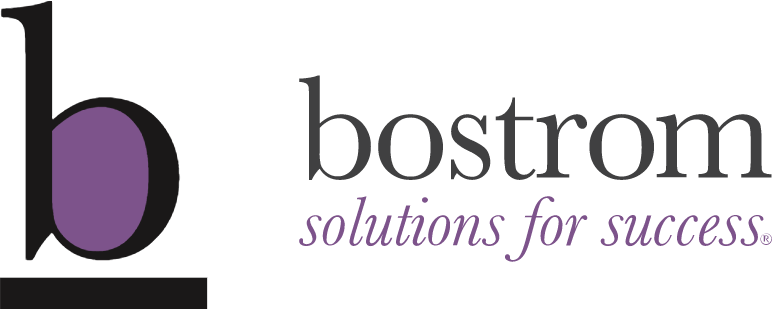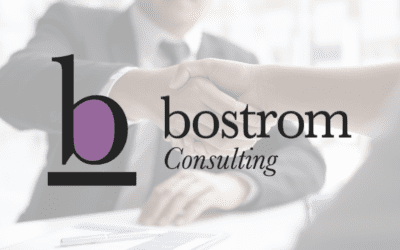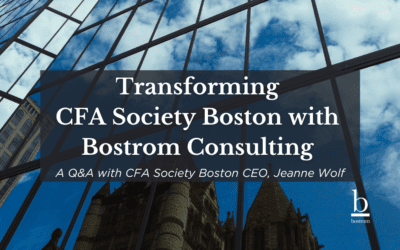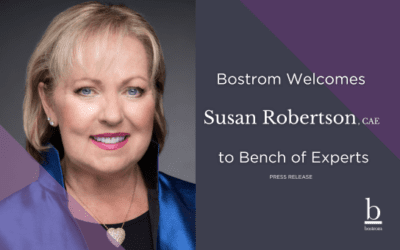This issue of Solutions addresses Bostrom’s commitment to providing associations with consulting services that meet the challenges and demands of today’s fast-paced environment. Many industries and professions are experiencing disruptive innovation – an innovation that creates a new market and value network and eventually disrupts the current one, displacing established market-leading firms, products, and alliances. The big driver of this, especially related to business models and membership models, is the pace of technology. This presents challenges and opportunities for associations which require a faster-paced, yet more focused approach.
In 2016-17, Bostrom conducted an in-depth review of its consulting practice aimed at identifying how to best serve the changing needs of associations. We identified five major areas of emphasis that all contribute to what we call Enterprise-wide Organizational Analysis:
- Business Modeling
- Revenue Diversification
- Integrated Marketing and Branding
- Human Capital Development
- Digital Strategy
These areas of emphasis are central to providing associations relevant support in today’s disruptive environment. Earlier analysis of Bostrom’s service offerings highlighted several themes consistent with the ongoing needs of associations, including the importance of agile management, the foundational relevance of organizational culture, and the recognition that employee expertise and commitment to excellence are, and always will be, the most critical asset of any association. These themes have been explored in previous editions of Solutions.
New Needs and Challenges
Social Media –One of the most critical needs is understanding and harnessing social media as a force in pursuing effective communications and marketing strategies. Associations must, therefore, adopt a multi-faceted strategy. Understanding member and customer preferences, and tailoring messages and modes of delivery to them is a daunting challenge that requires significant technical expertise, data mining, and instant feedback and response capability. The association’s website is a foundational element of this strategy but it must be supplemented by the wide variety of available social media outreach tools.
Business Models –The traditional 3-5 year strategic plan that mostly gathered dust on the shelf has been replaced by a business modeling methodology that encompasses the overall vision and strategic trajectory of the organization in addition to such critical elements of revenue diversification and market differentiation. Bostrom Consulting has built an approach to designing a “business model canvas” that captures the whole range of forces required to build a sound business model consistent with the fundamental mission and vision of the association, as well as positioning it to be responsive to the fast-changing business and membership environment.
Digital Strategy – Success in developing a responsive business model requires an understanding of the changing realities of the digital world and how to harness digital tools in a cost-efficient way. Associations need to tap into new ways of delivering value more efficiently and effectively through systems that use AI and marketing automation. A digital strategy goes beyond the acquisition and day-to-day application of hardware and software. It includes such things as how to tap into the “big data” movement to extract what your association needs, and how to access internal and external expertise to manage data and information flow required by your marketing strategies, business model, and major program initiatives. A digital strategy provides the tools to zero in on the information that is most relevant to your decision making needs.
Ongoing Needs and Challenges
Human Capital – Some things never change, and one of them is that associations are about people. However, the underlying reality that human capital is the heart and soul of an association requires an understanding of, and strategy for, how that critical asset relates to and serves the ongoing dynamics of the organization. For example, the human resources function must recognize the specific needs implicit in the business model, marketing strategy and digital strategy. The employee value proposition must be consciously designed and organization-wide, not the byproduct of specific hiring and selection decisions. The human capital strategy must take into account not only employees, but also members, customers, and officers. An association is a community and all players must be included in the human capital plan.
Corporate Culture – The second quarter 2018 issue of Solutions addressed the topic of corporate culture. Within Bostrom, we have been doing a deep dive into an examination of our own corporate culture and this process has given us a renewed appreciation of how critical culture is to every function and activity. I include it here as one of the “constants” of association needs not because culture is unchanging, but because it is always there and is always important. We summarize culture as “the personality” of the organization. It is the composite of how the association presents itself and is perceived, both internally and externally. Appreciating what culture is and understanding the reality of your culture is essential to your ability to meld all of your component parts into a cohesive whole that works efficiently and effectively. If, for example, your culture is not consistent with your communications strategy, the organization will not come across as genuine. There are many intangibles involved in assessing, designing and building an effective culture, and it is hard work. But investment in corporate culture is well worth the effort.
Bostrom’s emphasis in the past several years on agile management recognizes the fast-paced, disruptive environment today’s associations encounter. All of our services are geared to acknowledging that reality and helping associations deal effectively with it. Our recent rethinking of our consulting practice is part of that ongoing process.





